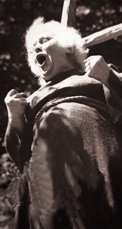It is 1623, Denmark, a hundred years after the Protestant reformation, and religious tide has swung from the sale of indulgences to theological fanaticism. Witchcraft trials occur with certain frequency, and any aberrant behavior is cause for denunciation. Herlof’s Marthe (Anna Svierkier), a morally weak woman who experiments with the occult, has been denounced as a witch, and implores assistance from Anne (Lisbeth Movin), the young wife of Reverend Absalon Pedersson (Thorkild Roose) to escape punishment. Years earlier, Anne’s mother had similarly been accused of witchcraft, but was spared from the stake by Absalon’s false testament in a reprehensible act designed to win Anne’s affection. But despite threats to reveal his deception to the religious court, Absalon remains silent. Herlof’s Marthe is sentenced to burn at the stake, and curses Absalon and the inquisitor Laurentius (Olaf Ussing) before her death. Soon, the Pedersson household is thrown into upheaval as Anne falls in love with Absalon’s son, Martin (Preben Lerdorff Rye), under the suspicious gaze of Absalon’s mother, Meret (Sigrid Neiiendam). Meret has long disapproved of Absalon’s marriage to the young Anne, criticizing their union as “scandalous”, and Anne’s overt fondness for Martin serves to reinforce her disdain. One evening, during a powerful storm, Absalon is called away to perform last rites for the terminally ill Laurentius. While awaiting his return, Anne admits to Martin her wish for her husband’s death, and, in declaring her tainted thoughts, opens herself to denunciation.
Using richly symbolic, precisely structured mise-en-scene, Carl Theodor Dreyer creates a rigid and austere atmosphere in Day of Wrath. The dour countenance of Absalon and Meret, wearing dark, stiff-collared clothing sharply contrast against Martin and Anne’s softer, accessible persona. Minimal lighting and shadows create a pervasive sense of darkness, reflecting society’s cruelty and intolerance in an age of spiritual enlightenment. (Note the cross patterned shadows cast by the windows in Absalon’s house.) Similar to The Passion of Joan of Arc, Dreyer shows the inquisitors in long panning shots in order to create a sense of paranoid scrutiny. Day of Wrath is a harrowing portrait of ideological persecution – the tragic consequences of a misdirected cruelty borne of intolerance and repression.
© Acquarello 2000. All rights reserved.
